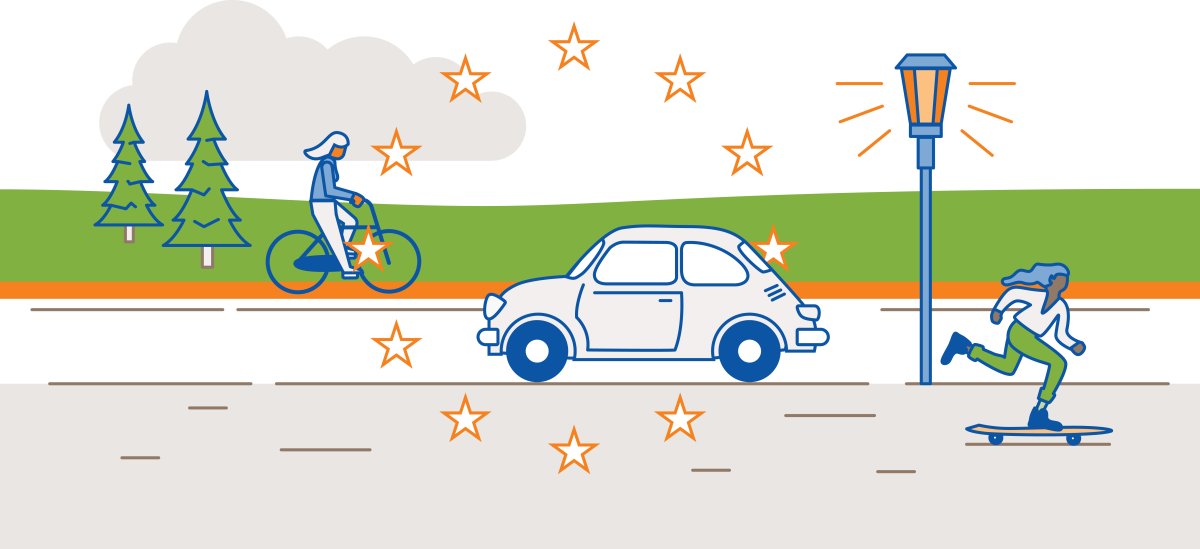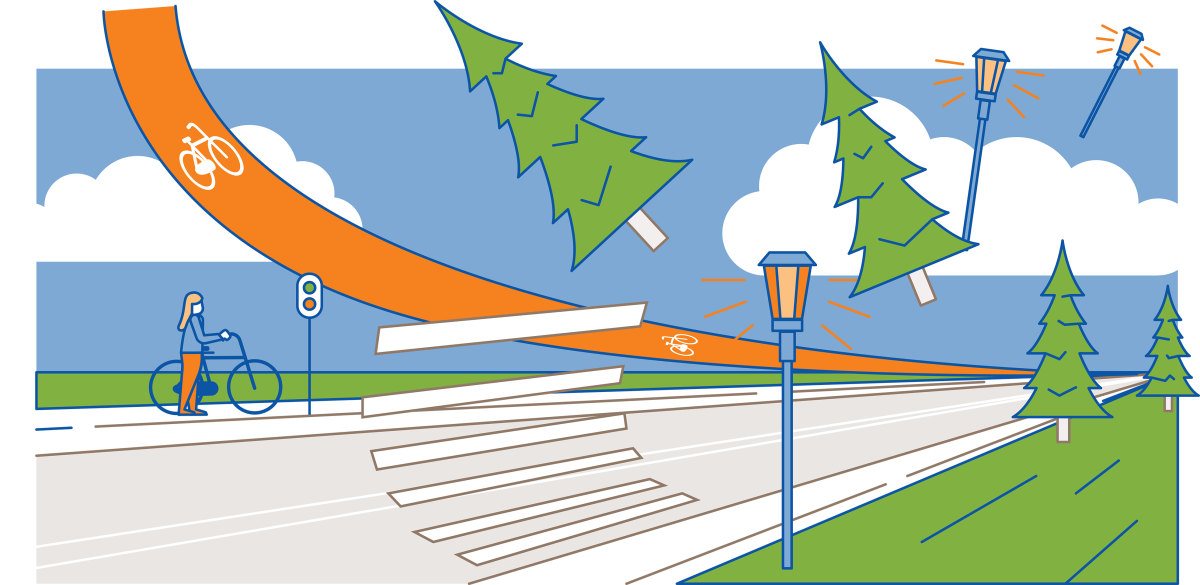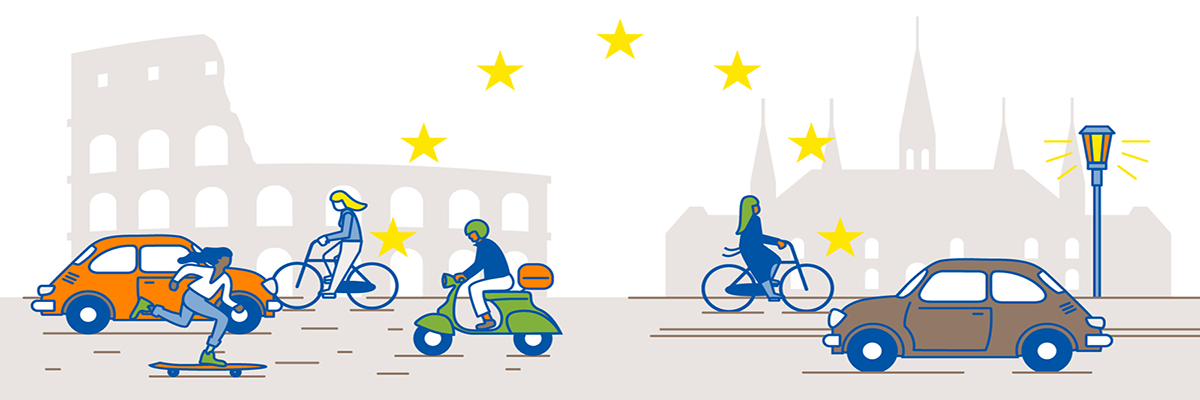Blog | 15 December 2023
Aiming for zero
Something to aim for
Vision Zero
With the Vision Zero strategy, the European Union aims for zero traffic fatalities by 2050. Is this realistic? ‘It’s crucial that in addition to Europe, all member states also commit to European goals,’ experts say. What’s the status of road safety in the European Union (EU)? Asking the question leads to a maze of statistics.
With 27 diverse countries, there are many different situations, numbers, and ways to interpret them. Dudley Curtis, spokesperson for the Brussels-based advocacy group European Transport Safety Council (ETSC), discusses the complexity at the micro-level: ‘Take the Netherlands. It has seen a significant increase in bicycle accidents, but there are also more cyclists, especially older people who can continue cycling longer thanks to e-bikes.’ The underlying question is complex: Is road safety declining, or are the elderly in the Netherlands generally healthier? There are many factors at play, and in various ways in the different EU member state.
Of course, there are lots of actual statistics. Several organizations, ranging from the European Commission (EC) to the ETSC, the intergovernmental International Traffic Safety Data and Analysis Group (IRTAD), and various national statistics bureaus, provide data. Mortality rates adjusted for population size are often used as a metric. However, for these data, the quality varies wildly. Sometimes for instance, only police records are available, whereas police records combined with hospital data are generally more comprehensive.

Positive trend
The data broadly show a positive trend. According to EC research, the mortality rate in EU countries has dropped by 17%, from 54 to 46 deaths per million inhabitants over the past decade. If we consider another period, from 2001 to 2016, the mortality rate even decreased by 53%. Diving in deeper, there are large disparities within Europe: Sweden (21 deaths per million inhabitants) and Denmark (26) perform much better than Romania (86) and Bulgaria (78).
Globally, Japan had 26 deaths per million in 2021, Australia had 43, the United States 129, and Colombia 142. If you consider the EU as a whole as a developed economy (which is debatable), then in terms of road safety, the political union is doing well.
No room for complacency
Still, there is no room for policymakers to rest on their laurels. As the EU’s Road Safety Policy Framework
2021-30 states: ‘More than 25,000 people still die on European roads every year, and more than 135,000
are seriously injured.’
Additionally, the decline in the number of road fatalities has stagnated in recent years, except for the COVID-19 years of 2020 and 2021.
For some years now, the EU, calling the number of road casualties ‘unacceptable’ in its policy framework, has been taking the initiative to improve road safety. Policymakers have introduced the goal of Vision Zero: zero deaths and serious injuries on European roads by 2050. An interim goal is to halve the number of deaths and injuries by 2030 compared to 2018.
The term Vision Zero wasn’t originally coined by the EU. The phrase was initially used for the so-called Safe System approach, introduced in the 1990s by the Netherlands and Sweden. In the Netherlands, it was called Sustainable Safety, while in Sweden it was named Vision Zero, explains Letty Aarts, the chief researcher at the Dutch Foundation for Scientific Research on Road Safety (FSRRS). ‘The underlying idea has remained the same. The system should be designed to prevent traffic accidents as much as possible.'
Blaming the road user
This idea stands in stark contrast to the traditional notion of blaming the road user. ‘When a road user crashes into a tree, one could say:
“He wasn’t paying attention.” But you could also argue:
“Had the tree not been there, the accident would not have been so severe”’, Aarts elaborates. This second approach places responsibility on those managing the roads to eliminate as many risk factors as possible.
So what’s happening in the context of EU goals? And is the European Union’s goal realistic?
In its pursuit of a safer system, the EU focuses on four main intervention areas: infrastructure, vehicle safety, safe road use (speed, alcohol and drugs, distractions, use of protective equipment such as helmets), and quick and efficient emergency aid.
Most legislation in the area of road safety is national or even local. Large cities often decide their own road safety measures. But Europe also has its tools. The most significant are the guidelines set by the European Commission, which serve as laws imposed on member states.
Cross-border traffic enforcement
A good example is cross-border traffic enforcement, says advocate Curtis. ‘If you’re a Frenchman caught speeding in the Germany, the Dutch authorities have the means, thanks to EU laws, to force you to pay the fine.’
Curtis provides another example, specifically safety standards for infrastructure, particularly for the so-called E-roads, which have guidelines on signalling, road design, and speed limits. Driving licences are another area of regulation’
Perhaps most importantly, according to Curtis, the EU sets standards for vehicle safety. ‘Every new car sold in one of the twenty-seven EU countries must meet minimum safety standards. For example, all new cars sold in the EU must have had an ABS anti-lock braking system since 2004 and an electronic stability program since 2011.’
In 2022, a whole new set of mandatory safety technologies was added, such as an autonomous emergency braking system, intelligent speed assistance, and lane assist. For inner-city traffic, mandatory parking sensors and a mandatory rear-view camera are important, among other things. Curtis says, ‘These technologies are now in every new vehicle that comes to market. This is a classic example of EU policy. It’s also a big success story and it has been the EU’s standard approach for many years.’

Largely voluntary
Then there is the second—and politically more challenging—aspect of EU policy: European integration. In addition to the guidelines, the EU is trying to put the Vision Zero concept on the map in all member states. ‘Since member states are mostly in charge of their own traffic laws, the EU cannot do much more than incentivise,’ says Aarts.
Yet the EU is also successful here. Aarts says: ‘More and more countries are adopting the Safe System approach and are moving towards risk-based policies.’ She points out that there is increasing international cooperation within the EU, with more and more countries participating. ‘The aim is to better identify those risk factors so that countries can base their policies on them and make Vision Zero a reality.’
Researcher Aerts refers to organisations such as ETSC, with the EU Road Safety Exchange program. There are also market initiatives, such as Euro NCAP—a non-profit organisation that tests car safety. And EuroRap, a non-profit that assesses the safety of European roads and collaborates with local authorities and national automobile clubs. ‘In general,’ Aerts states, ‘you can say that Western Europe is leading the way in developing the Safe System approach. The Scandinavian countries, in particular, are far ahead.’
Positive
Is enough being done? It’s clear that the EU can’t do it alone. Ultimately, all the ideas, both from the EU and from many initiatives in the field of road safety, must lead to a lot of action. Initially, the first interim goal is to halve the number of traffic injuries and fatalities by 2030. Aerts points out that in the Netherlands, for example, MP Jaco Geurts submitted a motion in 2021 to work on this interim goal. The motion was passed by the House of Representatives, but the cabinet did not prioritize it. ‘FSRRS has looked into whether that halving by 2030 is feasible, and it turned out to be very difficult,’ says Aerts. ‘So the question to politicians is: what are you going to do about it?’
In general, based on conversations with the two mentioned and a number of unmentioned interviewees, Europe is on the right track in the field of road safety. All countries—some more than others—are working to make improvements in areas such as enforcement, legislation, road networks, and speed limits. Lately, there has also been a lot of attention to vulnerable road users: pedestrians, cyclists, and new categories like electric scooter and monowheel riders.
Especially in cities, where vulnerable road users are overrepresented, caution is advised. In several countries the arrival of more and more vulnerable road users is being met with 30 km/h zones and vehicles with pedestrian-friendly fronts—mandatory across Europe since 2022— and technological systems that respond to pedestrians or cyclists.

The way forward
What is the way then forward for governments? ‘It’s crucial to set long-term goals,’ says Curtis of advocacy group ETSC. ‘How do you achieve a whole-of-government approach to meet the 2030 target? What are the criteria, who is responsible, how do you align the relevant authorities at a national level to achieve that goal?’ Wealthy Western European countries should not take their lead over Eastern European countries, often with less developed infrastructure, for granted. Curtis adds: ‘Take Poland, for example.
There is support at the highest level. You need resources, you need time, and you need money. Safer traffic doesn’t just ‘happen’.’ Road safety should be a top priority in the highest regions of politics.
Download
Urban Road Safety Index 2023
How do 25 European cities fare when it comes to road safety?
In 2023, we asked 7,515 people who use the roads in 25 European cities.
We wanted to know how safe they feel when they are on the road. We also asked whether they avoid certain traffic situations and whether residents are waiting for all this (electric) shared mobility in traffic at all.
Download the whole report for free at the link below!
